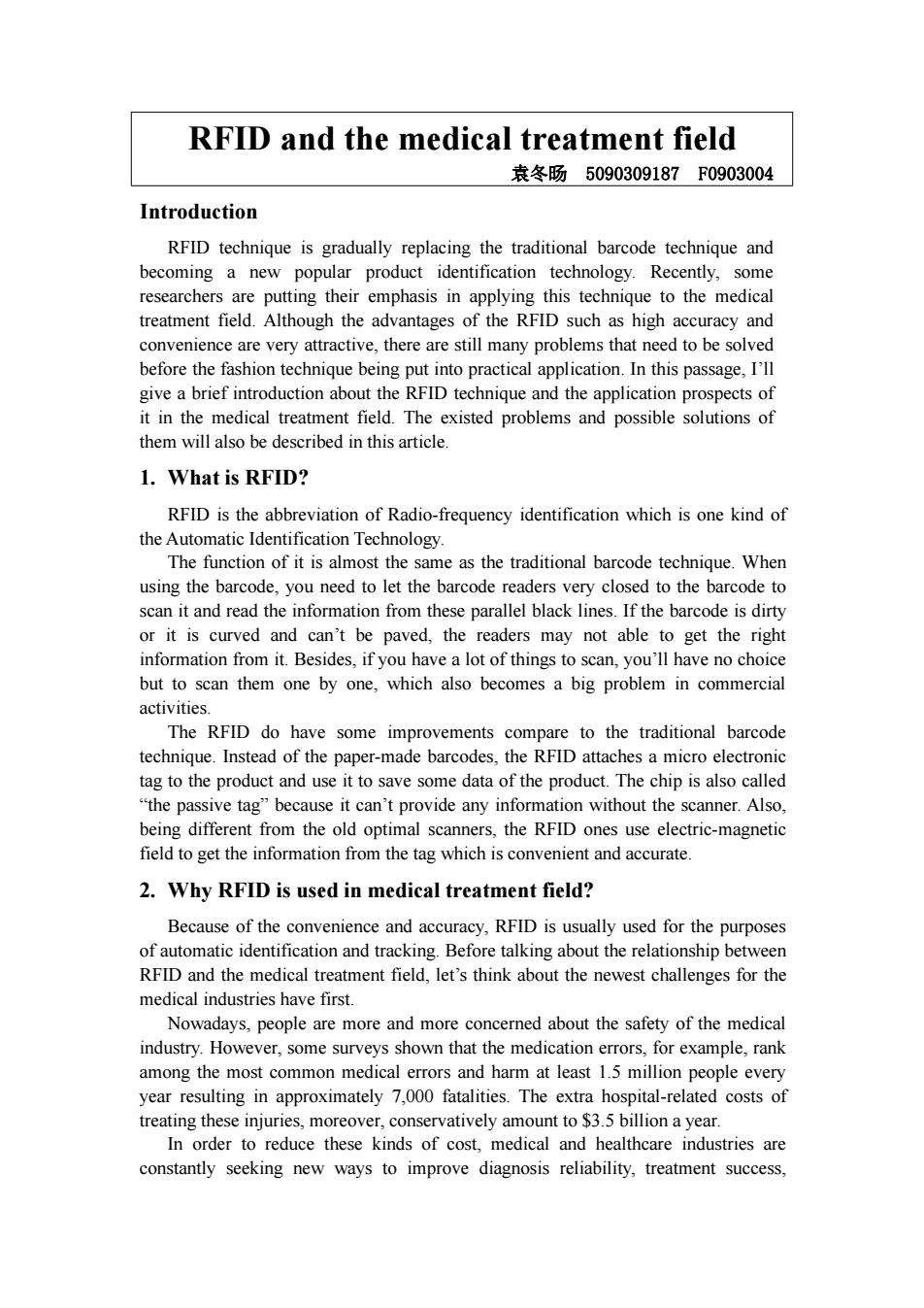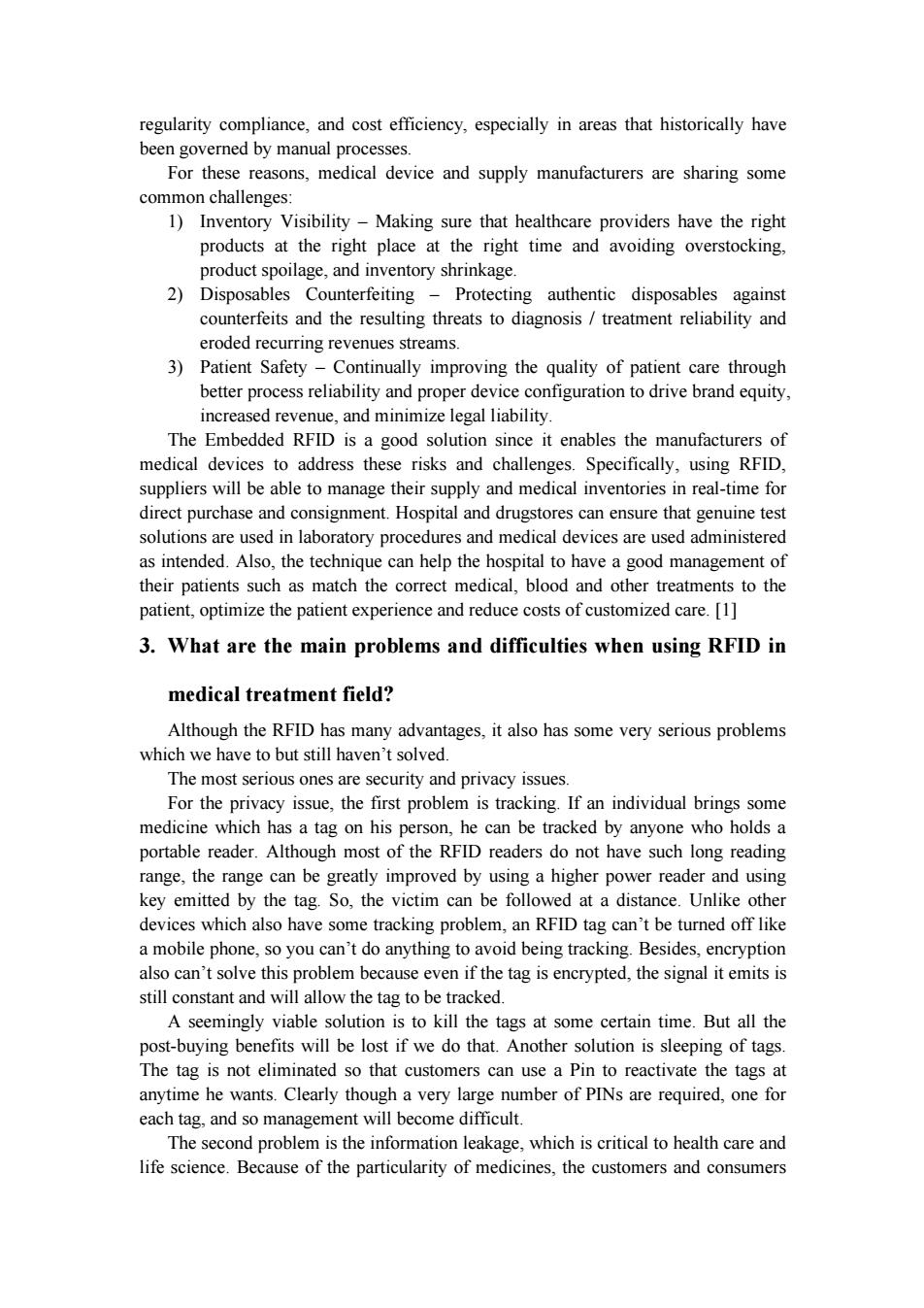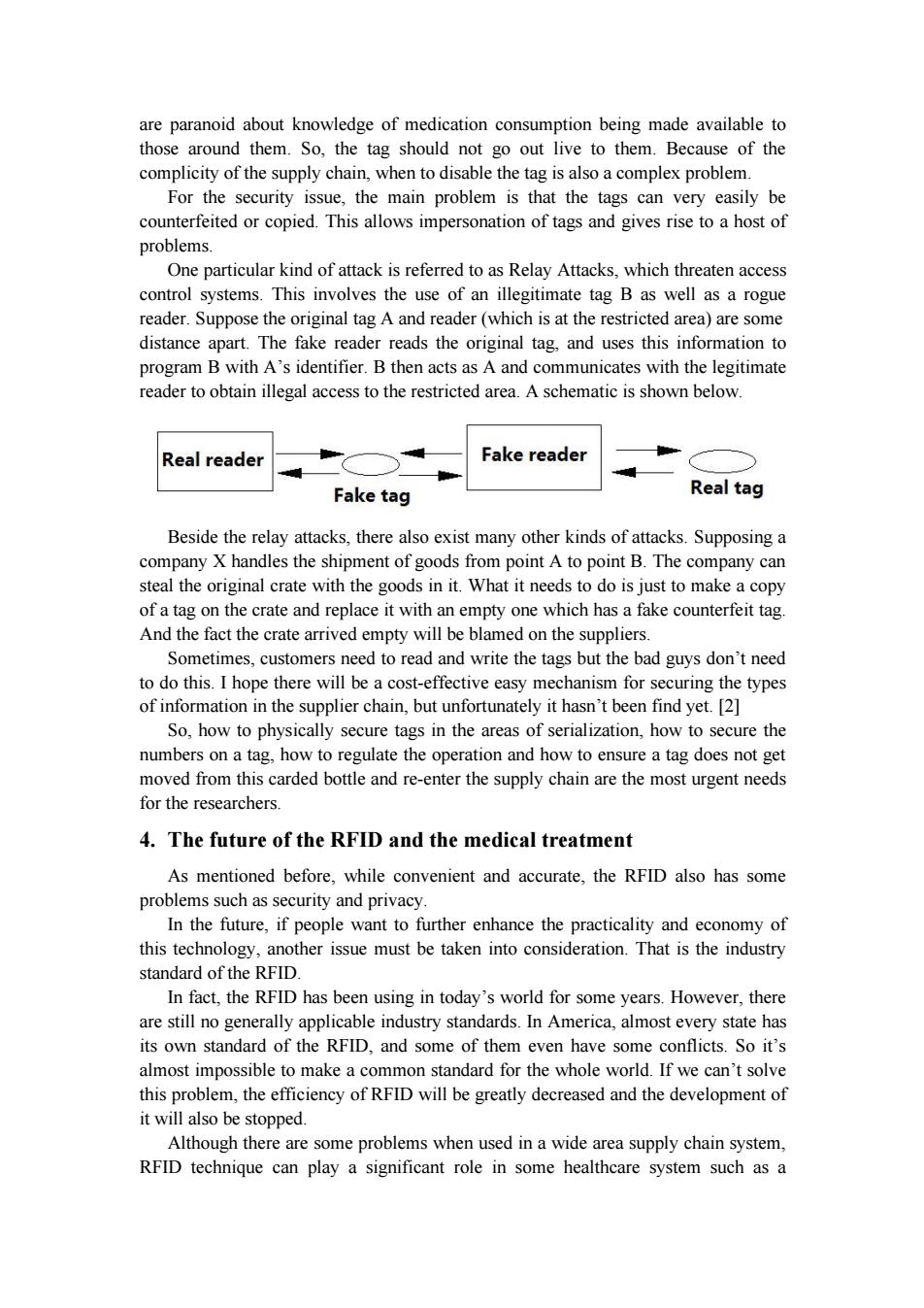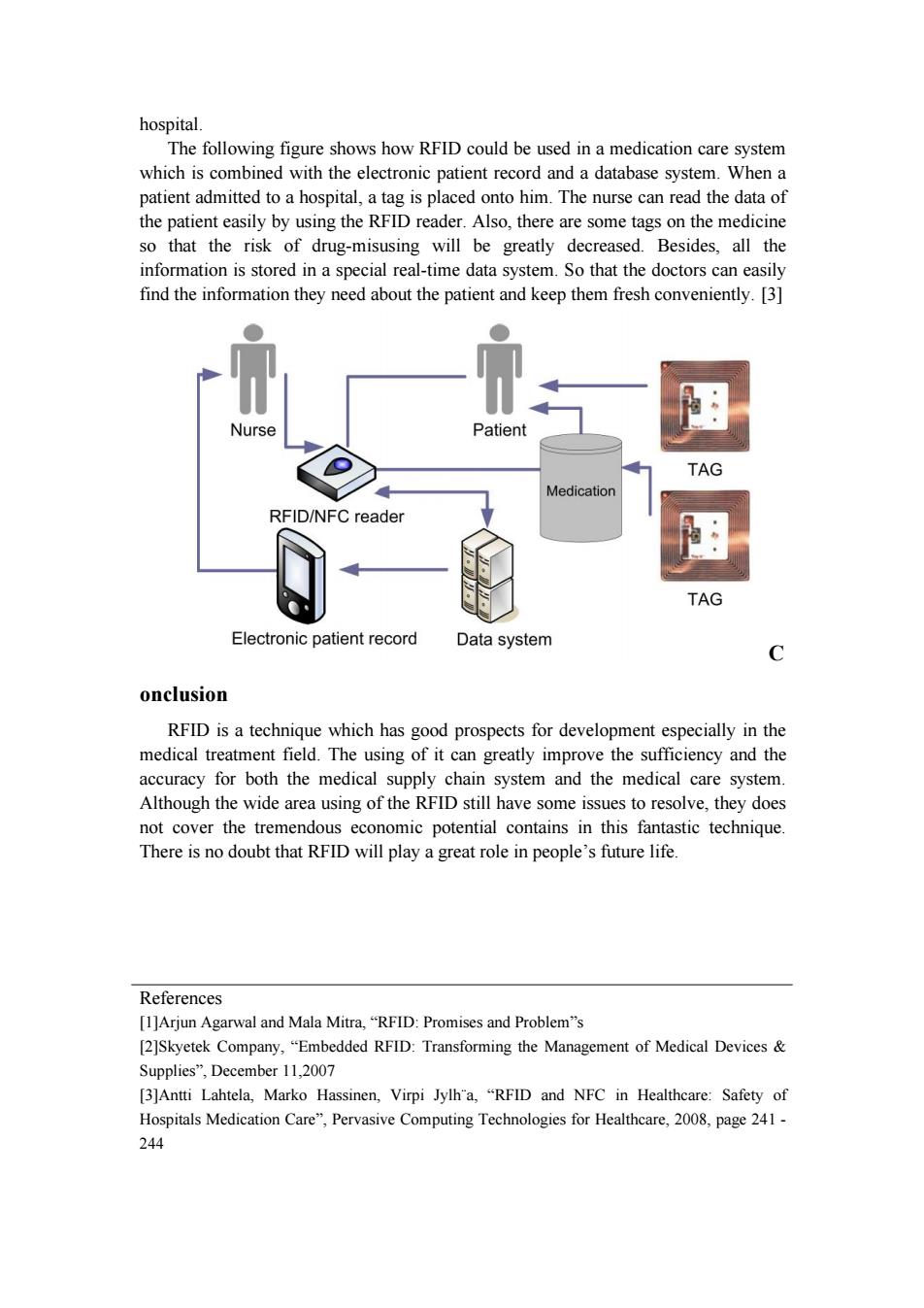
RFID and the medical treatment field 袁冬肠5090309187F0903004 Introduction RFID technique is gradually replacing the traditional barcode technique and becoming a new popular product identification technology.Recently,some researchers are putting their emphasis in applying this technique to the medical treatment field.Although the advantages of the RFID such as high accuracy and convenience are very attractive,there are still many problems that need to be solved before the fashion technique being put into practical application.In this passage,I'll give a brief introduction about the RFID technique and the application prospects of it in the medical treatment field.The existed problems and possible solutions of them will also be described in this article. 1.What is RFID? RFID is the abbreviation of Radio-frequency identification which is one kind of the Automatic Identification Technology. The function of it is almost the same as the traditional barcode technique.When using the barcode,you need to let the barcode readers very closed to the barcode to scan it and read the information from these parallel black lines.If the barcode is dirty or it is curved and can't be paved,the readers may not able to get the right information from it.Besides,if you have a lot of things to scan,you'll have no choice but to scan them one by one,which also becomes a big problem in commercial activities. The RFID do have some improvements compare to the traditional barcode technique.Instead of the paper-made barcodes,the RFID attaches a micro electronic tag to the product and use it to save some data of the product.The chip is also called "the passive tag"because it can't provide any information without the scanner.Also, being different from the old optimal scanners,the RFID ones use electric-magnetic field to get the information from the tag which is convenient and accurate. 2.Why RFID is used in medical treatment field? Because of the convenience and accuracy,RFID is usually used for the purposes of automatic identification and tracking.Before talking about the relationship between RFID and the medical treatment field,let's think about the newest challenges for the medical industries have first. Nowadays,people are more and more concerned about the safety of the medical industry.However,some surveys shown that the medication errors,for example,rank among the most common medical errors and harm at least 1.5 million people every year resulting in approximately 7,000 fatalities.The extra hospital-related costs of treating these injuries,moreover,conservatively amount to $3.5 billion a year. In order to reduce these kinds of cost,medical and healthcare industries are constantly seeking new ways to improve diagnosis reliability,treatment success
RFID and the medical treatment field 袁冬旸 5090309187 F0903004 Introduction RFID technique is gradually replacing the traditional barcode technique and becoming a new popular product identification technology. Recently, some researchers are putting their emphasis in applying this technique to the medical treatment field. Although the advantages of the RFID such as high accuracy and convenience are very attractive, there are still many problems that need to be solved before the fashion technique being put into practical application. In this passage, I’ll give a brief introduction about the RFID technique and the application prospects of it in the medical treatment field. The existed problems and possible solutions of them will also be described in this article. 1. What is RFID? RFID is the abbreviation of Radio-frequency identification which is one kind of the Automatic Identification Technology. The function of it is almost the same as the traditional barcode technique. When using the barcode, you need to let the barcode readers very closed to the barcode to scan it and read the information from these parallel black lines. If the barcode is dirty or it is curved and can’t be paved, the readers may not able to get the right information from it. Besides, if you have a lot of things to scan, you’ll have no choice but to scan them one by one, which also becomes a big problem in commercial activities. The RFID do have some improvements compare to the traditional barcode technique. Instead of the paper-made barcodes, the RFID attaches a micro electronic tag to the product and use it to save some data of the product. The chip is also called “the passive tag” because it can’t provide any information without the scanner. Also, being different from the old optimal scanners, the RFID ones use electric-magnetic field to get the information from the tag which is convenient and accurate. 2. Why RFID is used in medical treatment field? Because of the convenience and accuracy, RFID is usually used for the purposes of automatic identification and tracking. Before talking about the relationship between RFID and the medical treatment field, let’s think about the newest challenges for the medical industries have first. Nowadays, people are more and more concerned about the safety of the medical industry. However, some surveys shown that the medication errors, for example, rank among the most common medical errors and harm at least 1.5 million people every year resulting in approximately 7,000 fatalities. The extra hospital-related costs of treating these injuries, moreover, conservatively amount to $3.5 billion a year. In order to reduce these kinds of cost, medical and healthcare industries are constantly seeking new ways to improve diagnosis reliability, treatment success

regularity compliance,and cost efficiency,especially in areas that historically have been governed by manual processes. For these reasons,medical device and supply manufacturers are sharing some common challenges: 1)Inventory Visibility -Making sure that healthcare providers have the right products at the right place at the right time and avoiding overstocking, product spoilage,and inventory shrinkage. 2)Disposables Counterfeiting -Protecting authentic disposables against counterfeits and the resulting threats to diagnosis treatment reliability and eroded recurring revenues streams. 3)Patient Safety-Continually improving the quality of patient care through better process reliability and proper device configuration to drive brand equity, increased revenue,and minimize legal liability. The Embedded RFID is a good solution since it enables the manufacturers of medical devices to address these risks and challenges.Specifically,using RFID, suppliers will be able to manage their supply and medical inventories in real-time for direct purchase and consignment.Hospital and drugstores can ensure that genuine test solutions are used in laboratory procedures and medical devices are used administered as intended.Also,the technique can help the hospital to have a good management of their patients such as match the correct medical,blood and other treatments to the patient,optimize the patient experience and reduce costs of customized care.[1] 3.What are the main problems and difficulties when using RFID in medical treatment field? Although the RFID has many advantages,it also has some very serious problems which we have to but still haven't solved. The most serious ones are security and privacy issues. For the privacy issue,the first problem is tracking.If an individual brings some medicine which has a tag on his person,he can be tracked by anyone who holds a portable reader.Although most of the RFID readers do not have such long reading range,the range can be greatly improved by using a higher power reader and using key emitted by the tag.So,the victim can be followed at a distance.Unlike other devices which also have some tracking problem,an RFID tag can't be turned off like a mobile phone,so you can't do anything to avoid being tracking.Besides,encryption also can't solve this problem because even if the tag is encrypted,the signal it emits is still constant and will allow the tag to be tracked. A seemingly viable solution is to kill the tags at some certain time.But all the post-buying benefits will be lost if we do that.Another solution is sleeping of tags. The tag is not eliminated so that customers can use a Pin to reactivate the tags at anytime he wants.Clearly though a very large number of PINs are required,one for each tag,and so management will become difficult. The second problem is the information leakage,which is critical to health care and life science.Because of the particularity of medicines,the customers and consumers
regularity compliance, and cost efficiency, especially in areas that historically have been governed by manual processes. For these reasons, medical device and supply manufacturers are sharing some common challenges: 1) Inventory Visibility – Making sure that healthcare providers have the right products at the right place at the right time and avoiding overstocking, product spoilage, and inventory shrinkage. 2) Disposables Counterfeiting – Protecting authentic disposables against counterfeits and the resulting threats to diagnosis / treatment reliability and eroded recurring revenues streams. 3) Patient Safety – Continually improving the quality of patient care through better process reliability and proper device configuration to drive brand equity, increased revenue, and minimize legal liability. The Embedded RFID is a good solution since it enables the manufacturers of medical devices to address these risks and challenges. Specifically, using RFID, suppliers will be able to manage their supply and medical inventories in real-time for direct purchase and consignment. Hospital and drugstores can ensure that genuine test solutions are used in laboratory procedures and medical devices are used administered as intended. Also, the technique can help the hospital to have a good management of their patients such as match the correct medical, blood and other treatments to the patient, optimize the patient experience and reduce costs of customized care. [1] 3. What are the main problems and difficulties when using RFID in medical treatment field? Although the RFID has many advantages, it also has some very serious problems which we have to but still haven’t solved. The most serious ones are security and privacy issues. For the privacy issue, the first problem is tracking. If an individual brings some medicine which has a tag on his person, he can be tracked by anyone who holds a portable reader. Although most of the RFID readers do not have such long reading range, the range can be greatly improved by using a higher power reader and using key emitted by the tag. So, the victim can be followed at a distance. Unlike other devices which also have some tracking problem, an RFID tag can’t be turned off like a mobile phone, so you can’t do anything to avoid being tracking. Besides, encryption also can’t solve this problem because even if the tag is encrypted, the signal it emits is still constant and will allow the tag to be tracked. A seemingly viable solution is to kill the tags at some certain time. But all the post-buying benefits will be lost if we do that. Another solution is sleeping of tags. The tag is not eliminated so that customers can use a Pin to reactivate the tags at anytime he wants. Clearly though a very large number of PINs are required, one for each tag, and so management will become difficult. The second problem is the information leakage, which is critical to health care and life science. Because of the particularity of medicines, the customers and consumers

are paranoid about knowledge of medication consumption being made available to those around them.So,the tag should not go out live to them.Because of the complicity of the supply chain,when to disable the tag is also a complex problem. For the security issue,the main problem is that the tags can very easily be counterfeited or copied.This allows impersonation of tags and gives rise to a host of problems. One particular kind of attack is referred to as Relay Attacks,which threaten access control systems.This involves the use of an illegitimate tag B as well as a rogue reader.Suppose the original tag A and reader(which is at the restricted area)are some distance apart.The fake reader reads the original tag,and uses this information to program B with A's identifier.B then acts as A and communicates with the legitimate reader to obtain illegal access to the restricted area.A schematic is shown below. Real reader Fake reader Fake tag Real tag Beside the relay attacks,there also exist many other kinds of attacks.Supposing a company X handles the shipment of goods from point A to point B.The company can steal the original crate with the goods in it.What it needs to do is just to make a copy of a tag on the crate and replace it with an empty one which has a fake counterfeit tag. And the fact the crate arrived empty will be blamed on the suppliers. Sometimes,customers need to read and write the tags but the bad guys don't need to do this.I hope there will be a cost-effective easy mechanism for securing the types of information in the supplier chain,but unfortunately it hasn't been find yet.[2] So,how to physically secure tags in the areas of serialization,how to secure the numbers on a tag,how to regulate the operation and how to ensure a tag does not get moved from this carded bottle and re-enter the supply chain are the most urgent needs for the researchers. 4.The future of the RFID and the medical treatment As mentioned before,while convenient and accurate,the RFID also has some problems such as security and privacy. In the future,if people want to further enhance the practicality and economy of this technology,another issue must be taken into consideration.That is the industry standard of the RFID. In fact,the RFID has been using in today's world for some years.However,there are still no generally applicable industry standards.In America,almost every state has its own standard of the RFID,and some of them even have some conflicts.So it's almost impossible to make a common standard for the whole world.If we can't solve this problem,the efficiency of RFID will be greatly decreased and the development of it will also be stopped. Although there are some problems when used in a wide area supply chain system, RFID technique can play a significant role in some healthcare system such as a
are paranoid about knowledge of medication consumption being made available to those around them. So, the tag should not go out live to them. Because of the complicity of the supply chain, when to disable the tag is also a complex problem. For the security issue, the main problem is that the tags can very easily be counterfeited or copied. This allows impersonation of tags and gives rise to a host of problems. One particular kind of attack is referred to as Relay Attacks, which threaten access control systems. This involves the use of an illegitimate tag B as well as a rogue reader. Suppose the original tag A and reader (which is at the restricted area) are some distance apart. The fake reader reads the original tag, and uses this information to program B with A’s identifier. B then acts as A and communicates with the legitimate reader to obtain illegal access to the restricted area. A schematic is shown below. Beside the relay attacks, there also exist many other kinds of attacks. Supposing a company X handles the shipment of goods from point A to point B. The company can steal the original crate with the goods in it. What it needs to do is just to make a copy of a tag on the crate and replace it with an empty one which has a fake counterfeit tag. And the fact the crate arrived empty will be blamed on the suppliers. Sometimes, customers need to read and write the tags but the bad guys don’t need to do this. I hope there will be a cost-effective easy mechanism for securing the types of information in the supplier chain, but unfortunately it hasn’t been find yet. [2] So, how to physically secure tags in the areas of serialization, how to secure the numbers on a tag, how to regulate the operation and how to ensure a tag does not get moved from this carded bottle and re-enter the supply chain are the most urgent needs for the researchers. 4. The future of the RFID and the medical treatment As mentioned before, while convenient and accurate, the RFID also has some problems such as security and privacy. In the future, if people want to further enhance the practicality and economy of this technology, another issue must be taken into consideration. That is the industry standard of the RFID. In fact, the RFID has been using in today’s world for some years. However, there are still no generally applicable industry standards. In America, almost every state has its own standard of the RFID, and some of them even have some conflicts. So it’s almost impossible to make a common standard for the whole world. If we can’t solve this problem, the efficiency of RFID will be greatly decreased and the development of it will also be stopped. Although there are some problems when used in a wide area supply chain system, RFID technique can play a significant role in some healthcare system such as a

hospital. The following figure shows how RFID could be used in a medication care system which is combined with the electronic patient record and a database system.When a patient admitted to a hospital,a tag is placed onto him.The nurse can read the data of the patient easily by using the RFID reader.Also,there are some tags on the medicine so that the risk of drug-misusing will be greatly decreased.Besides,all the information is stored in a special real-time data system.So that the doctors can easily find the information they need about the patient and keep them fresh conveniently.[3] Nurse Patient TAG Medication RFID/NFC reader TAG Electronic patient record Data system C onclusion RFID is a technique which has good prospects for development especially in the medical treatment field.The using of it can greatly improve the sufficiency and the accuracy for both the medical supply chain system and the medical care system. Although the wide area using of the RFID still have some issues to resolve,they does not cover the tremendous economic potential contains in this fantastic technique. There is no doubt that RFID will play a great role in people's future life. References [1]Arjun Agarwal and Mala Mitra,"RFID:Promises and Problem"s [2]Skyetek Company,"Embedded RFID:Transforming the Management of Medical Devices Supplies",December 11,2007 [3]Antti Lahtela,Marko Hassinen,Virpi Jylh"a,"RFID and NFC in Healthcare:Safety of Hospitals Medication Care",Pervasive Computing Technologies for Healthcare,2008,page 241- 244
hospital. The following figure shows how RFID could be used in a medication care system which is combined with the electronic patient record and a database system. When a patient admitted to a hospital, a tag is placed onto him. The nurse can read the data of the patient easily by using the RFID reader. Also, there are some tags on the medicine so that the risk of drug-misusing will be greatly decreased. Besides, all the information is stored in a special real-time data system. So that the doctors can easily find the information they need about the patient and keep them fresh conveniently. [3] C onclusion RFID is a technique which has good prospects for development especially in the medical treatment field. The using of it can greatly improve the sufficiency and the accuracy for both the medical supply chain system and the medical care system. Although the wide area using of the RFID still have some issues to resolve, they does not cover the tremendous economic potential contains in this fantastic technique. There is no doubt that RFID will play a great role in people’s future life. References [1]Arjun Agarwal and Mala Mitra, “RFID: Promises and Problem”s [2]Skyetek Company, “Embedded RFID: Transforming the Management of Medical Devices & Supplies”, December 11,2007 [3]Antti Lahtela, Marko Hassinen, Virpi Jylh¨a, “RFID and NFC in Healthcare: Safety of Hospitals Medication Care”, Pervasive Computing Technologies for Healthcare, 2008, page 241 - 244